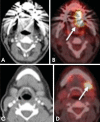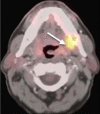Basic principles and applications of (18)F-FDG-PET/CT in oral and maxillofacial imaging: A pictorial essay
- PMID: 25473642
- PMCID: PMC4245476
- DOI: 10.5624/isd.2014.44.4.325
Basic principles and applications of (18)F-FDG-PET/CT in oral and maxillofacial imaging: A pictorial essay
Abstract
A combination of positron emission tomography (PET) with (18)F-labeled fluoro-2-deoxyglucose ((18)F-FDG) and computed tomography ((18)F-FDG-PET/CT) has increasingly become a widely used imaging modality for the diagnosis and management of head and neck cancer. On the basis of both recent literature and our professional experience, we present a set of principles with pictorial illustrations and clinical applications of FDG-PET/CT in the evaluation and management planning of squamous cell carcinoma of the oral cavity and oropharynx. We feel that this paper will be of interest and will aid the learning of oral and maxillofacial radiology trainees and practitioners.
Keywords: Head and Neck Neoplasms; Positron-Emission Tomography; Tomography, X-Ray Computed.
Figures













References
-
- Chandra R. Nuclear medicine physics: the basics. 6th ed. Philadelphia: Lippincott Williams & Wilkins; 2004.
-
- Blodgett TM, Fukui MB, Snyderman CH, Branstetter BF, 4th, McCook BM, Townsend DW, et al. Combined PET-CT in the head and neck: part 1. Physiologic, altered physiologic, and artifactual FDG uptake. Radiographics. 2005;25:897–912. - PubMed
-
- Jemal A, Siegel R, Ward E, Murray T, Xu J, Smigal C, et al. Cancer statistics, 2006. CA Cancer J Clin. 2006;56:106–130. - PubMed
-
- Forastiere A, Koch W, Trotti A, Sidransky D. Head and neck cancer. N Engl J Med. 2001;345:1890–1900. - PubMed
-
- Antoch G, Vogt FM, Freudenberg LS, Nazaradeh F, Goehde SC, Barkhausen J, et al. Whole-body dual-modality PET/CT and whole-body MRI for tumor staging in oncology. JAMA. 2003;290:3199–3206. - PubMed
Publication types
LinkOut - more resources
Full Text Sources
Other Literature Sources

